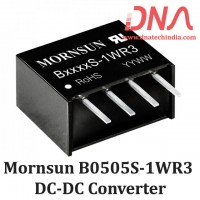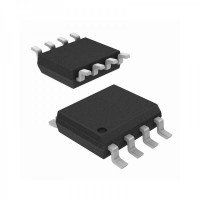Capacitor Characteristics |
||
|
There are a bewildering array of capacitor characteristics and specifications associated with the humble capacitor and reading the information printed onto the body of a capacitor can sometimes be difficult especially when colours or numeric codes are used. Each family or type of capacitor uses its own unique identification system with some systems being easy to understand, and others that use misleading letters, colours or symbols. The best way to figure out what a capacitor label means is to first figure out what type of family the capacitor belongs to whether it is ceramic, film, plastic or electrolytic. |
||
|
Even though two capacitors may have exactly the same capacitance value, they may have different voltage ratings. If a smaller rated voltage capacitor is substituted in place of a higher rated voltage capacitor, the increased voltage may damage the smaller capacitor. Also we remember from the last tutorial that with a polarised electrolytic capacitor, the positive lead must go to the positive connection and the negative lead to the negative connection otherwise it may again become damaged. So it is always better to substitute an old or damaged capacitor with the same type as the specified one. An example of capacitor markings is given below. |
||
|
|
||
Capacitor Characteristics |
||
|
|
||
|
The capacitor, as with any other electronic component, comes defined by a series of characteristics. These Capacitor Characteristics can always be found in the datasheets that the capacitor manufacturer provides to us so here are just a few of the more important ones. |
||
|
|
||
1. Nominal Capacitance, (C) |
||
|
The nominal value of the Capacitance, C of a capacitor is measured in pico-Farads (pF), nano-Farads (nF) or micro-Farads (µF) and is marked onto the body of the capacitor as numbers, letters or coloured bands. The capacitance of a capacitor can change value with the circuit frequency (Hz) y with the ambient temperature. Smaller ceramic capacitors can have a nominal value as low as one pico-Farad, ( 1pF ) while larger electrolytic's can have a nominal capacitance value of up to one Farad, ( 1F ). All capacitors have a tolerance rating that can range from -20% to as high as +80% for aluminium electrolytic's affecting its actual or real value. The choice of capacitance is determined by the circuit configuration but the value read on the side of a capacitor may not necessarily be its actual value. |
||
|
|
||
2. Working Voltage, (WV) |
||
|
The Working Voltage is the maximum continuous voltage either DC or AC that can be applied to the capacitor without failure during its working life. Generally, the working voltage printed onto the side of a capacitors body refers to its DC working voltage, ( WV-DC ). DC and AC voltage values are usually not the same for a capacitor as the AC voltage value refers to the r.m.s. value and NOT the maximum or peak value which is 1.414 times greater. Also, the specified DC working voltage is valid within a certain temperature range, normally - 30°C to + 70°C. Any DC voltage in excess of its working voltage or an excessive AC ripple current may cause failure. It follows therefore, that a capacitor will have a longer working life if operated in a cool environment and within its rated voltage. Common working DC voltages are 10V, 16V, 25V, 35V, 50V, 63V, 100V, 160V, 250V, 400V and 1000V and are printed onto the body of the capacitor. |
||
|
|
||
3. Tolerance, (±%) |
||
| As with resistors, capacitors also have a Tolerance rating expressed as a plus-or-minus value either in picofarad's (±pF) for low value capacitors generally less than 100pF or as a percentage (±%) for higher value capacitors generally higher than 100pF. The tolerance value is the extent to which the actual capacitance is allowed to vary from its nominal value and can range anywhere from -20% to +80%. Thus a 100µF capacitor with a ±20% tolerance could legitimately vary from 80µF to 120µF and still remain within tolerance. Capacitors are rated according to how near to their actual values they are compared to the rated nominal capacitance with coloured bands or letters used to indicated their actual tolerance. The most common tolerance variation for capacitors is 5% or 10% but some plastic capacitors are rated as low as ±1% | ||
|
|
||
4. Leakage Current |
||
|
The dielectric used inside the capacitor to separate the conductive plates is not a perfect insulator resulting in a very small current flowing or "leaking" through the dielectric due to the influence of the powerful electric fields built up by the charge on the plates when applied to a constant supply voltage. This small DC current flow in the region of nano-amps (nA) is called the capacitors Leakage Current. Leakage current is a result of electrons physically making their way through the dielectric medium, around its edges or across its leads and which will over time fully discharging the capacitor if the supply voltage is removed. |
||
When the leakage is very low such as in film or foil type capacitors it is generally referred to as "insulation resistance" ( Rp ) and can be expressed as a high value resistance in parallel with the capacitor as shown. When the leakage current is high as in electrolytic's it is referred to as a "leakage current" as electrons flow directly through the electrolyte. Capacitor leakage current is an important parameter in amplifier coupling circuits or in power supply circuits, with the best choices for coupling and/or storage applications being Teflon and the other plastic capacitor types (polypropylene, polystyrene, etc) because the lower the dielectric constant, the higher the insulation resistance. |
||
| Electrolytic-type capacitors (tantalum and aluminum) on the other hand may have very high capacitances, but they also have very high leakage currents (typically of the order of about 5-20 μA per µF) due to their poor isolation resistance, and are therefore not suited for storage or coupling applications. Also, the flow of leakage current for aluminium electrolytic's increases with temperature. | ||
|
|
||
5. Working Temperature, (T) |
||
|
Changes in temperature around the capacitor affect the value of the capacitance because of changes in the dielectric properties. If the air or surrounding temperature becomes to hot or to cold the capacitance value of the capacitor may change so much as to affect the correct operation of the circuit. The normal working range for most capacitors is -30°C to +125°C with nominal voltage ratings given for a Working Temperature of no more than +70°C especially for the plastic capacitor types. Generally for electrolytic capacitors and especially aluminium electrolytic capacitor, at high temperatures (over +85°C the liquids within the electrolyte can be lost to evaporation, and the body of the capacitor (especially the small sizes) may become deformed due to the internal pressure and leak outright. Also, electrolytic capacitors can not be used at low temperatures, below about -10°C, as the electrolyte jelly freezes. |
||
|
|
||
6. Temperature Coefficient, (TC) |
||
|
The Temperature Coefficient of a capacitor is the maximum change in its capacitance over a specified temperature range. The temperature coefficient of a capacitor is generally expressed linearly as parts per million per degree centigrade (PPM/°C), or as a percent change over a particular range of temperatures. Some capacitors are non linear (Class 2 capacitors) and increase their value as the temperature rises giving them a temperature coefficient that is expressed as a positive "P". Some capacitors decrease their value as the temperature rises giving them a temperature coefficient that is expressed as a negative "N". For example "P100" is +100 ppm/°C or "N200", which is -200 ppm/°C etc. However, some capacitors do not change their value and remain constant over a certain temperature range, such capacitors have a zero temperature coefficient or "NPO". These types of capacitors such as Mica or Polyester are generally referred to as Class 1 capacitors. |
||
|
Most capacitors, especially electrolytic's lose their capacitance when they get hot but temperature compensating capacitors are available in the range of at least P1000 through to N5000 (+1000 ppm/C through to -5000 ppm/C). It is also possible to connect a capacitor with a positive temperature coefficient in series or parallel with a capacitor having a negative temperature coefficient the net result being that the two opposite effects will cancel each other out over a certain range of temperatures. Another useful application of temperature coefficient capacitors is to use them to cancel out the effect of temperature on other components within a circuit, such as inductors or resistors etc. |
||
|
|
||
7. Polarization |
||
Capacitor Polarization generally refers to the electrolytic type capacitors but mainly the Aluminium Electrolytic's, with regards to their electrical connection. The majority are polarized types, that is the voltage connected to the capacitor terminals must have the correct polarity, i.e. positive to positive and negative to negative. Incorrect polarization can cause the oxide layer inside the capacitor to break down resulting in very large currents flowing through the device resulting in destruction as we have mentioned earlier. The majority of electrolytic capacitors have their negative, -ve terminal clearly marked with either a black stripe, band, arrows or chevrons down one side of their body as shown, to prevent any incorrect connection to the DC supply. Some larger electrolytic's have their metal can or body connected to the negative terminal but high voltage types have their metal can insulated with the electrodes being brought out to separate spade or screw terminals for safety. Also, when using aluminium electrolytic's in power supply smoothing circuits care should be taken to prevent the sum of the peak DC voltage and AC ripple voltage from becoming a "reverse voltage". |
||
|
|
||
8. Equivalent Series Resistance, (ESR) |
||
|
The Equivalent Series Resistance or ESR, of a capacitor is the AC impedance of the capacitor when used at high frequencies and includes the resistance of the dielectric material, the DC resistance of the terminal leads, the DC resistance of the connections to the dielectric and the capacitor plate resistance all measured at a particular frequency and temperature. |
||
In some ways, ESR is the opposite of the insulation resistance which is presented as a pure resistance (no capacitive or inductive reactance) in parallel with the capacitor. An ideal capacitor would have only capacitance but ESR is presented as a pure resistance (less than 0.1Ω) in series with the capacitor (hence the name Equivalent Series Resistance), and which is frequency dependant making it a "DYNAMIC" quantity. |
||
|
As ESR defines the energy losses of the "equivalent" series resistance of a capacitor it must therefore determine the capacitor's overall I2R heating losses especially when used in power and switching circuits. Capacitors with a relatively high ESR have less ability to pass current to and from its plates to the external circuit because of their longer charging and discharging RC time constant. The ESR of electrolytic capacitors increases over time as their electrolyte dries out. Capacitors with very low ESR ratings are available and are best suited when using the capacitor as a filter. |
||
|
As a final note, capacitors with small capacitances (less than 0.01 uF) generally do not pose much danger to humans. However, when the capacitances start to exceed 0.1 uF, touching the capacitor leads can be a shocking experience. For example, large electrolytic reservoir capacitors found in television sets and photo flashes can store a lethal charge. As a rule, never touch the leads of large capacitors. If in question, discharge the capacitor first by shorting the leads together with a screwdriver tip before handling it. |
||
|
The next tutorial in our section about Capacitors, we look at how they store electrical charge on their plates and use it to calculate the capacitance value. |
||
|
|
||
| Reproduced with permission from Wayne Storr | ||
| ( http://www.electronics-tutorials.ws/capacitor/cap_3.html ) | ||







